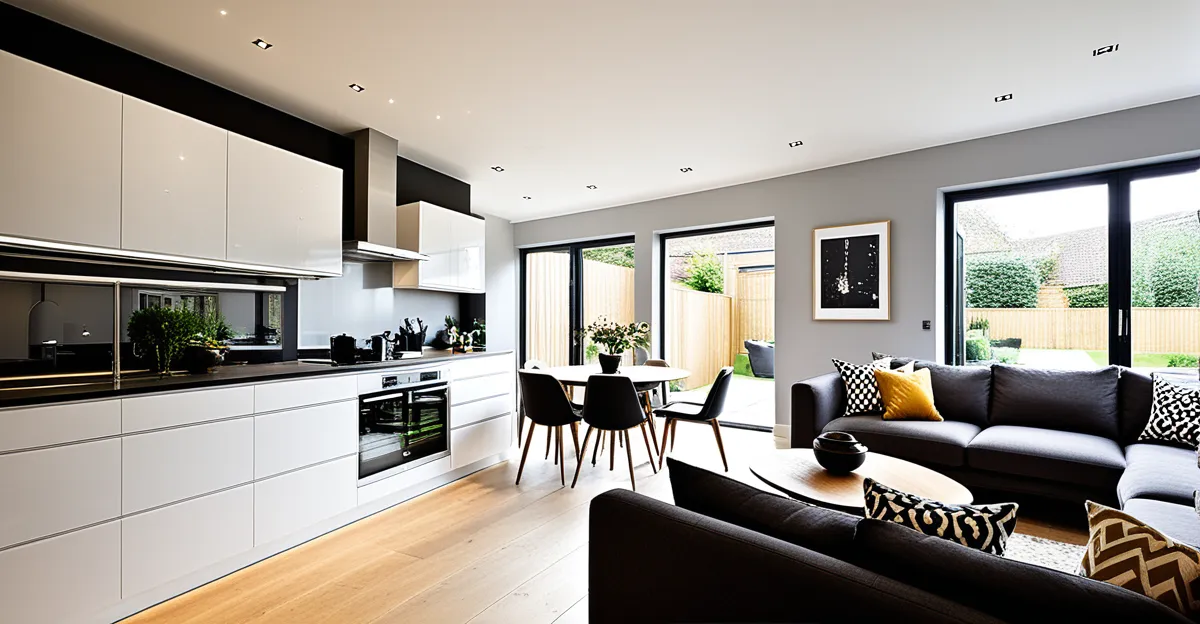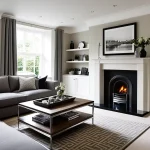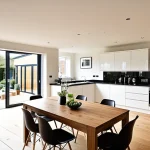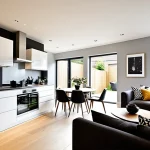Key Design Trends Shaping UK Living Spaces
In the UK, home design trends increasingly reflect a fusion of tradition and modernity. Contemporary interiors here are shaped by evolving lifestyle needs and cultural influences. One notable emerging trend is the emphasis on creating practical yet stylish environments that accommodate changing work-from-home routines and family dynamics.
Societal shifts such as sustainability awareness and technology adoption strongly influence these trends. For example, homes now often blend classic British architectural features—like sash windows or exposed brick—with sleek, minimalist furnishings. This integration respects heritage while embracing modern design principles, allowing for balanced spaces that feel both timeless and fresh.
Also to see : What Are the Pros of Open-Plan Living in UK Homes?
Open-plan living and flexible layouts are also gaining traction, reflecting the demand for adaptable rooms that serve multiple functions. Such designs foster social interaction, natural light flow, and a sense of spaciousness in often compact UK homes. The popularity of these trends highlights a broader desire for interiors that enhance daily life with convenience and aesthetic appeal.
Ultimately, the UK’s contemporary interiors continue to evolve by incorporating unique local elements alongside global design innovations, creating distinctive and dynamic living spaces.
Also to read : How Can You Add a Touch of Elegance to Your UK Living Space?
Emphasis on Sustainability and Eco-Friendly Materials
Sustainable home design UK is rapidly shaping contemporary interiors. Increasingly, homeowners prioritize eco-friendly interiors by selecting green materials that reduce environmental impact. Common sustainable materials include reclaimed wood, bamboo, and recycled metals. These materials not only add warmth and texture but also align with ecological responsibility.
Energy-efficient solutions play a crucial role in sustainable home design UK. Double-glazed windows, enhanced insulation, and energy-saving lighting are popular choices that improve comfort while lowering utility costs. Furthermore, smart eco-tech features—like programmable thermostats and solar panels—integrate seamlessly into modern homes, offering both sustainability and convenience.
Real-world examples of eco-friendly interiors highlight how UK home design trends merge style with function. For instance, living spaces may incorporate natural fabrics and indoor plants to enhance air quality and aesthetics simultaneously. These choices reflect broader societal shifts toward environmental awareness and resource mindfulness.
In summary, sustainable home design UK combines materials, technology, and lifestyle adjustments in a balanced approach. Homeowners benefit from innovative yet responsible solutions that respect both heritage and the planet. This focus on sustainability is a defining characteristic of emerging trends in UK interiors.
Rise of Smart Home Technology in Everyday Living
Smart home trends UK have surged as homeowners increasingly embrace home automation to enhance convenience and control. Current adoption rates reveal a strong preference for smart thermostats, security cameras, and voice-activated assistants. These devices streamline routine tasks and contribute to energy efficiency, aligning with broader lifestyle demands.
How does technology integration improve everyday living? It boosts comfort by allowing precise environment adjustments and ensures security through real-time monitoring. For instance, smart lighting systems adapt to natural light levels, reducing electricity use while maintaining ambiance.
Integrating smart home devices into UK homes is practical and scalable. In living rooms, automated blinds or multi-room speakers create immersive environments. Kitchens benefit from smart appliances that optimize cooking times and energy usage. Bedrooms see advances with sleep-tracking devices and climate control for better rest quality.
These emerging trends show that technology is not merely an add-on but a core element shaping contemporary interiors in the UK. By blending seamlessly with traditional and sustainable design choices, smart home technology transforms residential spaces into dynamic, responsive environments suited to modern lives.
Flexible Spaces and Open-Plan Living
UK home design trends increasingly favour open-plan design UK concepts, prioritising adaptable, multi-functional spaces that accommodate diverse activities. The growing demand stems from lifestyle changes, such as remote working and more communal living, which require rooms to serve various purposes simultaneously. This shift reflects a critical emerging trend central to contemporary interiors.
Balancing openness with areas of privacy remains essential. Experts recommend using subtle room dividers, sliding panels, or furniture arrangements to create zones without compromising space flow. This approach maintains the airy, spacious feel while offering retreat spots for individual needs.
Transitioning traditional UK layouts into flexible ones involves removing unnecessary partitions or redesigning underused rooms to maximize adaptability. Homeowners benefit from improved natural light flow and social interaction, key advantages of an open-plan design UK strategy.
Such flexible layouts also embrace features like fold-away desks, modular furniture, and hidden storage, enhancing usability without sacrificing style. Integrating these elements within classic British architectural details results in harmonious, functional homes that respond dynamically to daily life demands. Overall, multi-functional spaces are a defining characteristic of modern UK interiors, reflecting practical design merged with aesthetic appeal.
Inspiration from Biophilic and Natural Design Elements
Biophilic design UK is an important emerging trend that highlights a deeper connection between occupants and nature. This approach uses natural materials like wood, stone, and linen to add warmth and texture. Incorporating organic textures creates visually calming interiors that promote wellbeing. For example, exposed wooden beams or stone feature walls bring an authentic natural touch to contemporary interiors.
Maximising natural light is another key aspect of biophilic design UK. Large windows and skylights increase sunlight exposure, which enhances mood and reduces reliance on artificial lighting. This is especially beneficial in urban UK homes where natural light can be limited.
Indoor plants and greenery are widely used to strengthen indoor-outdoor living connections. Strategically placing plants improves air quality and introduces dynamic textures and colours, balancing hard materials commonly found in modern British interiors.
Many UK homes adopt biophilic design by creating seamless transitions between indoor and outdoor spaces—using sliding doors to patios or integrating garden views into living areas. Such design strategies embody a harmonious blend of style and sustainability while addressing lifestyle needs in compact city homes. This approach exemplifies how UK home design trends are evolving to celebrate nature thoughtfully and practically.
Colour, Texture, and Personal Expression in Modern Interiors
In contemporary UK interior colour trends, there is a clear shift toward rich, muted tones paired with natural textures. Popular palettes often include deep greens, warm terracottas, and soft neutrals, which complement the natural materials featured in wider UK home design trends. This combination creates balanced and inviting spaces that feel both fresh and grounded.
Personalised interiors are gaining importance, reflecting homeowners’ unique tastes and stories. Eclectic décor choices—mixing vintage pieces with modern accents—allow individuals to craft spaces that express their identity. This approach responds to a desire for homes that feel truly lived-in and comfortable, rather than overly styled.
Material choices contribute significantly to texture and depth, with fabric selections like velvet, linen, and wool increasing in popularity for upholstery and drapery. These tactile elements enhance comfort and add visual interest.
Experts predict a continued evolution toward more adventurous personal expression within UK interiors. This means future home decor trends will likely encourage bold colour contrasts and distinctive accessories, allowing residents to design spaces that are both stylish and soulful. Overall, embracing colour, texture, and personal touches is a defining feature of today’s UK home design trends.







